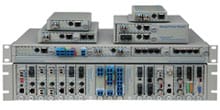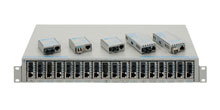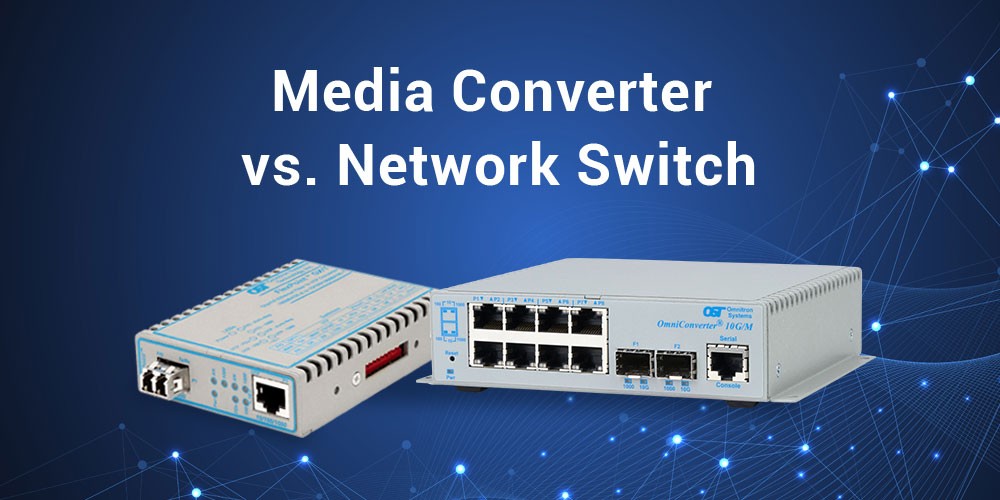- Products
- PoE Media Converters and Switches
- Ethernet & PoE Switches Product Selector
- Multi-Gigabit Ethernet and PoE Switches
- PoE PSE Commercial Switches
- PoE PSE Industrial Fiber Switches
- PoE Industrial Copper Extenders
- PoE Powered Media Converters
- PoE PSE Media Converters
- PoE Extenders & Injectors Product Selector
- Pluggable Transceivers Product Selector
- Single Pair PoE Products
- Product Lines

- iConverter Managed Multi-service Platform
- Copper to Fiber Media Converters
- Ethernet Media Converters
- 10 Gigabit Copper-to-Fiber
- 10/100/1000 Copper to 10 Gigabit Fiber
- 10/100/1000 Copper-to-Fiber with Integrated Management
- 10/100/1000 Industrial Copper-to-Fiber with Integrated Management
- 10/100/1000 Copper-to-Fiber with VLAN
- 10/100/1000 Dual Media Converter with VLAN
- Gigabit Copper-to-Fiber
- 10/100 Copper-to-Fiber with Integrated Management
- 10/100 Industrial Copper-to-Fiber with Integrated Management
- 10/100 Copper-to-Fiber with VLAN
- 10/100 Copper-to-Fiber
- Fast Ethernet Copper-to-Fiber
- Fast Ethernet Redundant Links
- 10Mbps Copper-to-Fiber
- 10Mbps Copper to Coax
- TDM Media Converters
- Serial Media Converters
- Ethernet Media Converters
- Fiber to Fiber Media Converters
- 10 Gigabit Fiber-to-Fiber Converter and Transponder
- 10 Gigabit Industrial Converter and Transponder
- SFP-to-SFP Fiber Converter and Transponder
- SFP-to-SFP Industrial Fiber Converter and Transponder
- Gigabit Fiber to-Fiber with 3 Rs
- 100/1000 Fiber-to-Fiber with 3 Rs
- Gigabit Fiber-to-Fiber
- Fast Ethernet Fiber-to-Fiber with 3 Rs
- Fast Ethernet Fiber-to-Fiber
- OC-3/STM-1 Fiber-to-Fiber
- OC-12/STM-4 Fiber-to-Fiber
- Carrier Ethernet Network Interface Devices
- CE 2.0 - 10G Demarcation NID
- CE 2.0 - 10/100/1000 Mult-port NID
- CE 2.0 - 10/100/1000 Mult-port NID with PoE
- CE 2.0 - 10/100/1000 8-Port NID
- CE 1.0 Service OAM - 10/100/1000 NID
- CE 1.0 Link OAM - 10/100/1000 Copper-to-Fiber NID
- CE 1.0 Link OAM - 10/100 Copper-to-Fiber NID
- CE 1.0 Link OAM - Gigabit Fiber-to-Fiber NID
- CE 1.0 Link OAM - Fast Ethernet Fiber-to-Fiber NID
- CWDM Multiplexers
- T1/E1 Multiplexers
- Ethernet Switch Modules
- Management System
- Chassis Options

- 1-Module Industrial Chassis

- RuggedNet Industrial Switches and Extenders
- Industrial PoE PSE Fiber Switches
- Multi-Gigabit Managed Industrial PoE+/BT Switches
- Multi-Gigabit Unmanaged Industrial PoE+/BT Switches
- 10G Managed 802.3bt PoE Switches
- 10G Unmanaged 802.3bt PoE Switches
- 10G Managed PoE+ Switches
- 10G Unmanaged PoE+ Switches
- 1G Managed PoE+ Switches
- 1G Unmanaged PoE+ Switches
- 1G Unmanaged 802.3bt PoE Switches
- 1G Managed 802.3bt PoE Switches
- Industrial SPE Switches
- Industrial Ethernet Switches
- Industrial PoE Copper Extenders
- Industrial Power Supplies

- OmniConverter Media Converter, Switches and Extenders
- PoE PSE Media Converters
- 10G Multi-Gigabit / Multi-Rate PoE Media Converter
- 10G Multi-Gigabit / Multi-Rate Media Converter
- 10/100 Multi-port PoE+ Media Converter
- 10/100 PoE+ Media Converter
- 10/100/1000 Multi-Port PoE+ Media Converter
- Industrial 10/100/1000 Multi-Port PoE+ Media Converter
- 10/100/1000 PoE+ Media Converter
- 10/100/1000 PoE++ 60W-100W Media Converter
- Industrial 10/100 Multi-port PoE+ Media Converter
- 1U Rack-Mount Shelf
- PoE PSE Compact Switches
- Multi-Gigabit Managed PoE+/BT Switches
- Multi-Gigabit Unmanaged PoE+/BT Switches
- 10G Managed 802.3bt PoE Switches
- 10G Unmanaged 802.3bt PoE Switches
- 10G Managed PoE+ Switches
- 10G Unmanaged PoE+ Switches
- 1G Managed PoE+ Switches
- 1G Unmanaged PoE+ Switches
- 1G Managed 802.3bt PoE Switches
- 1G Unmanaged 802.3bt PoE Switches
- Ethernet Switches
- Single Pair Ethernet (SPE)
- PoE Copper Extenders
- PoE Injectors

- miConverter Unmanaged Miniature Media Converters
- 10/100/1000 Copper-to-Fiber
- Industrial 10/100/1000 Copper-to-Fiber
- 10/100/1000 Ultra-Compact Copper-to-Fiber
- Gigabit Copper-to-Fiber
- 10/100/1000 Copper-to-Fiber PoE Powered
- 10/100 Copper-to-Fiber
- 10/100 Ultra-Compact Copper-to-Fiber
- 10/100 Copper-to-Fiber PoE Powered
- 18-Module Chassis
- Industrial 10/100 Copper-to-Fiber PoE Powered

- FlexSwitch Compact Switches
- Solutions
- Company
- Support
- How to Buy
Media Converter vs. Network Switch: Which One Should You Choose?

In the ever-evolving realm of networking technology, two crucial components stand out: Media Converters and Network Switches. Both serve essential roles in ensuring seamless data transmission and maintaining smooth network connectivity. But when faced with the choice of Media Converter vs. Network Switch, which should you opt for? In this blog, we'll explore the key differences between these two devices and shed light on when each should be deployed to optimize network performance.
Media Converter vs. Network Switch: What Are the Differences?
A media converter is designed to implement fiber in a network and is used to connect two different media types. The media converter is used to access the WAN network and transmit data over fiber optic cables.
Media Converters serve as the unsung heroes in networking, specializing in the conversion of signals from one media type to another. This is particularly valuable when dealing with diverse network infrastructures. Imagine a scenario where you need to connect fiber-optic cabling to copper-based equipment – this is where a Media Converter comes into play.
Network Switches, on the other hand, are the traffic directors of a network, managing data traffic efficiently within a local area network (LAN), and connecting more devices.
A network switch connects devices to receive, process, and send data to the destination device. The effective communication between devices has made the network switch a popular choice for network architects. It is interesting to know that by sharing data and allocating resources, the network switch saves money for businesses.
Transmission Rate Comparison: Media Converters vs. Network Switches
Media converters and network switches have also evolved to cater to diverse data rate requirements. Network switches are available in various configurations, including 10/100Mbps, 1G, 2.5G, 5G, 10G, 25G, 100G as well as Multi-Gig / Multi-rate. These switches empower network architects and administrators to select the optimal infrastructure for their specific needs, whether building a small-scale office network or a high-capacity data center environment.
On the other hand, fiber media converters come with data rates of 10 Mbps, 100 Mbps, 1 Gbps, 10 Gbps and also Multi-Gig / Multi-rate . Among these options, the 10/100 Mbps and 1 Gbps media converters are more commonly deployed and have emerged as the most cost-effective solution.
Installation Comparison: Media Converters vs. Network Switches
Media converters offer a quick and simple means of establishing connections. They can be installed on a desktop, wall or rack-mounted, or installed within a chassis; their installation process is straightforward, as they are plug-and-play devices. It involves providing power to the media converter (AC, DC, USB or PoE) and inserting the relevant cables into the copper and fiber ports of the media converter and connecting these cables to the network devices at each end.
In contrast, network switches provide a broader range of options and features, catering to various network sizes and complexities. A configuration level is necessary for managed network switches to unleash advanced features like SNMP, VLAN, IGMP, and others. This configuration enables administrators to operate the network and optimize performance, making managed switches suitable for more intricate network setups.
However, there are also unmanaged switches that are plug-and-play just like media converters and can be preset with the use of DIP switches. So depending on the features included in the network switch, installation time can vary.
Functional Comparison: Media Converters vs. Network Switches
Media converters specialize in signal conversion and link extension, adapting various types of fibers (multimode and single-mode fiber or dual fiber and single fiber) and wavelengths (Wavelength Division Multiplexing), while network switches, particularly Layer 2, Layer 3, and Layer 4 switches, provide multifaceted networking functions driven by the specific needs of the network layer.
The choice between media converters and network switches hinges on the network's requirements, with media converters excelling in connectivity adaptation and switches offering advanced network management capabilities, and the ability to connect more devices.
Media Converter vs. Network Switch: Which Should You Choose?
The choice between media converters and network switches in an Ethernet network depends on budget, required transmission distances, and network expansion. Additionally, these devices can address specific network challenges, highlighting the versatility and adaptability of modern network infrastructure solutions.
Media converters typically have 1 or 2 fiber ports and 1 or 2 RJ-45 Ethernet ports, while switches will have 1 or more fiber ports or RJ-45 uplink ports, and have 4 or more RJ-45 Ethernet ports.
So if you are extending fiber to just one or two devices that have an RJ-45 copper port, a media converter will do the job and is the most cost-effective solution.
But if you are running fiber or UTP to an area with 2 or more connected devices, a network switch will be the best choice.
Here’s a handy guide to use when deciding between a Media Converter vs. a Network Switch:
Use Media Converters when:
- Dealing with different media types (converting copper to fiber)
- Extending network reach over longer distances
- For electrical isolation between devices
Use Network Switches when:
- Managing traffic within a local area network (LAN)
- Segmenting broadcast domains to reduce congestion
- Prioritizing data based on MAC addresses
Conclusion
There are different media converters and network switches on the market. You can choose the most suitable network device according to your network needs. Omnitron Systems is a privately held company headquartered in Irvine, California, and manufactures all its products in the United States. If you have any further questions or want to get pre-sale support, give us a call; we are available 24/7 to answer your questions.
Call or email us now to get pre-sale support.
At Omnitron, we understand that network design is essential to any successful IT infrastructure. That's why we offer free network design services to our customers. Our experienced network engineers will collaborate with you to develop a comprehensive design that meets your unique needs, budget, and time limit.
Schedule a free network design session









